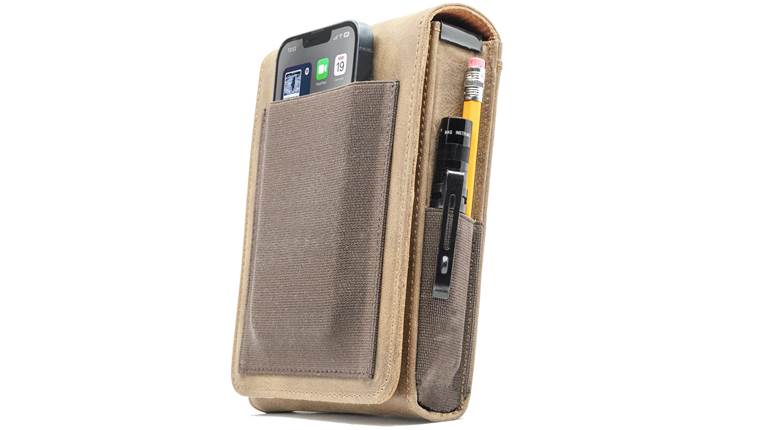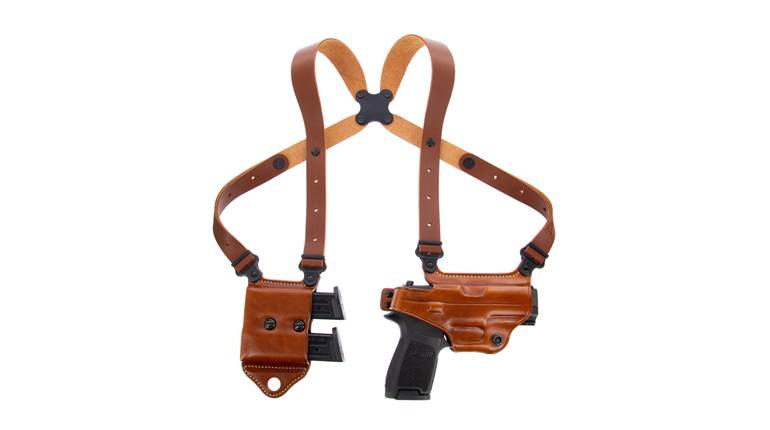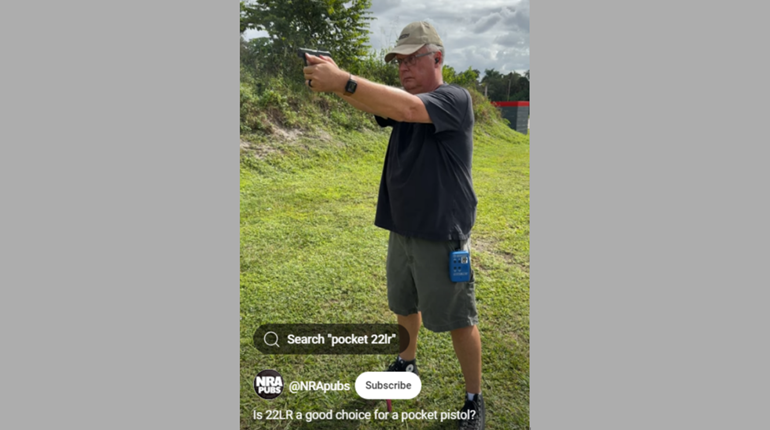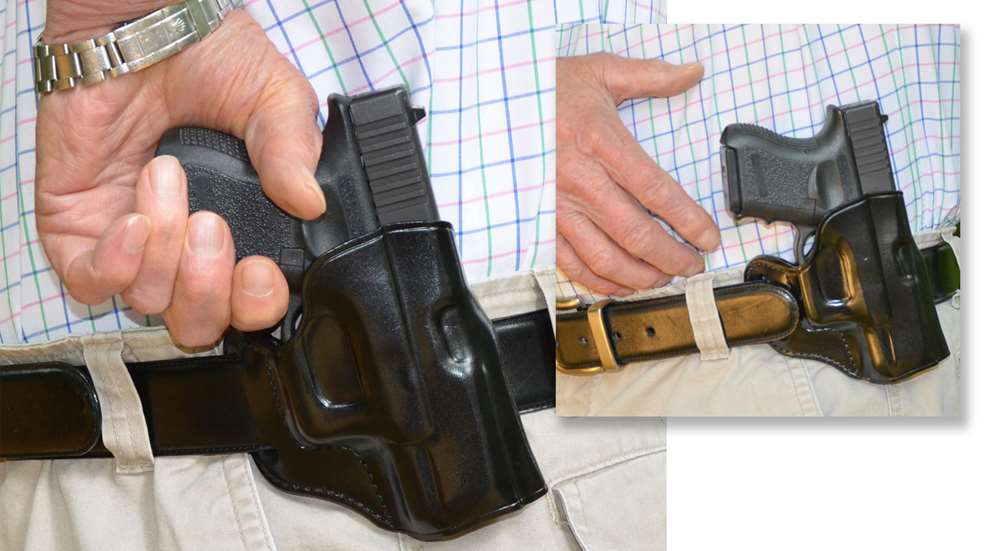
Revolvers ruled when I began carrying a handgun for personal defense in the 1960s. An uncle was the county sheriff, and because he spent most of his duty time behind a desk and in meetings, he often carried a Smith & Wesson Chief’s Special in .38 Spl. with a 2" barrel. It seemed only natural for my first carry gun to be the same, and I still have it. Leather for the little revolver was horse-traded from a friend who had purchased it from holster maker Gordon Davis.
Moving forward to the ‘80s, I became involved in United States Practical Shooting Ass’n (USPSA) action pistol competition and started with a custom M1911 pistol carried in a Fas-Trac leather holster made by Ernie Hill. For personal protection, I chose a custom Colt Officer’s ACP, and since small waist packs were the rage at the time, I often carried it in an Escort made by Galco. With its entire front held in place by Velcro, a quick tug on a ripcord exposed the handgun for a reasonably fast draw.
Then, suddenly and without warning, I became a Glockaholic and have since carried most models, beginning with the first generation. When buying a G27 in .40 S&W, I chose a Kramer Belt Scabbard made of horsehide that may never wear out. Today, I often carry a 9 mm Luger-chambered Glock 19, and my wife carries the G27 in a fashionable Galco handbag that has a quickly accessible interior pocket for the gun. There have been other carry guns in our lives, with a 9 mm Springfield Armory Hellcat wearing an RMSc red-dot sight being a recent acquisition. For outside-the-waistband carry (OWB), it rests in a pancake-style Predator from Wright Leather Works. For inside-the-waistband (IWB) carry, I use a CrossBreed MiniTuck, and the thinness of it and the Hellcat make for a very comfortable combination.
All of these experiences have informed my decisions, and, today, the options for handgun carry are nearly limitless. Manufacturers sometimes use a body-clock diagram to indicate the optimum position in which a particular belt holster is designed to be worn. Viewed from above, the belly button is at 12 o’clock, 3 o’clock is directly at the right side, 6 o’clock is the small-of-the-back position and 9 o’clock is at the left. Viewed from the side, most holsters designed for strong-side wear will tilt the gun forward approximately 10 to 15 degrees. This makes a holster easier to draw from, and since the grip of the gun is positioned in a more vertical alignment with the body than in a neutral-rake holster, its butt is less likely to show, or “print,” through light clothing.
Leather is my favorite material, and I have holsters made of horsehide and cowhide. Horsehide is supposed to be a bit more sweat-resistant but everything including quality being the same, I have yet to see a big difference between the two. And speaking of leather quality, it can vary considerably, with the hard-molded holster being superior in gun retention and longevity to inexpensive soft holsters.
Favorable characteristics, including low cost, durability and excellent shape retention, make Kydex a popular alternative to leather. One of the best designs to come along is constructed by attaching a Kydex shell to a leather backing; I especially like this type of holster for IWB carry. Many companies offer it, but in this category, CrossBreed is certainly one of the leaders of the pack. I have been carrying various handguns in CrossBreed MiniTuck and SuperTuck holsters for quite a few years, and I have found that the wide leather backing distributes pressure over a large area of the body, giving the design an extremely high comfort factor rating. In IWB carry, the rigid shell greatly resists collapsing from pressure applied by a belt, resulting in fumble-free re-holstering. Should gun fit not be snug enough, the shell of some hybrids can be carefully spot-heated with a hair dryer and slightly re-shaped. Online videos explain how this is done.
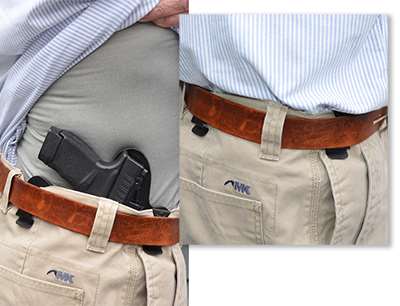
Inside-The-Waistband Carry
According to Mike Barham at Galco, holster sales between IWB and OWB fall about 60/40 in favor of IWB. There are reasons for this. Whereas the entire holster and its contents are exposed in OWB carry, only the grip of the gun is exposed in IWB. For this reason, the gun can be concealed by an outer garment of shorter length. And since the holster holds the firearm closer to the body, the gun is not as likely to print through outer clothing.
There are two basic variations. When a coat or a shirt with its long tail hanging out is worn, the standard type is a good choice. If that outer garment has to be removed in a public place or not worn at all, a tuckable holster such as my favorite, the CrossBreed MiniTuck, is a very good choice. As the tail of a shirt is being tucked into the pants, retention clips, straps or hooks attached to the belt allow the shirt to be positioned over the top of the gun and between the holster and the waistband of the pants. Allowing the shirt to uniformly blouse out a bit all around the waist appears natural and further enhances its ability to hide the gun from sight. Use of the tuck-in feature is optional and is not needed when the holster is worn beneath an outer garment.
Regardless of who makes it, the IWB holster has shortcomings. If pant fit is snug without the holster, an additional inch or two will be needed in the waist measurement when the holster is present. That means having pants altered or buying new ones. And since the belt goes over the top of the holster, additional length may be needed there as well. Back to the positive side, an IWB holster gives you another good reason for shedding a few pounds of excess body weight—or not visiting the pizza parlor quite as often.
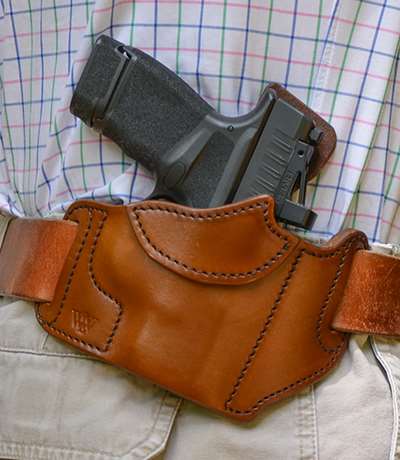
Outside-The-Waistband Carry
Belt-attached holsters resting outside the waistband are extremely popular, with a number of variations offered by most companies. In leather, I prefer the pancake style because the wide spacing of its belt slots draws the gun quite close to the wearer’s body when the belt is comfortably tightened. This makes the grip of a gun less likely to print through clothing than when in a holster with closer belt-slot spacing. Excellent examples that I have used are the Predator from Wright Leather Works, the Wilson Low Profile, the Galco Concealable, the DeSantis Mini Slide and the CrossBreed SnapSlide. Some pancake holsters are available with a thumb-break-style retention strap, with the Galco Gladius and DeSantis Tac-Lite being good examples; higher levels of retention are usually reserved for holsters made of Kydex or other synthetic materials.
Moving to the hiding-in-plain-sight category, we have the Sneaky Pete, which I am told has a huge following. Lurking inside what appears to be nothing more than an innocent container for a smartphone or other device is a fully loaded handgun. You can even get one labeled “First Aid Kit,” “Insulin Pump,” “Hazardous Materials” or “Dangerous! High Voltage” to further disguise it. A couple of strong magnets hold the cover flap firmly in place, and yet my compact 9 mm Luger handgun is easily accessed by a flick of the thumb. A number of colors are available and material options are leather and synthetic with either belt loops or clips.
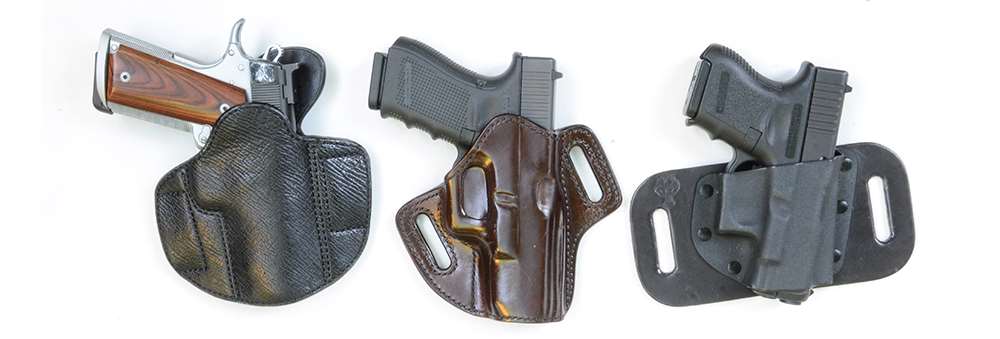
Cross-Draw Carry
Not much is said or written about cross-draw holsters, but Scott Wright, co-owner of Wright Leather Works, tells me that the Regulator is second in popularity among his OWB holster line. As the name indicates, the gun rests in a butt-forward position on the non-dominant side, and the dominant hand reaches across the front of the body to draw the pistol. Spending many hours of practice drawing an unloaded gun is important because when the weak-side hand is used to pull back the tail of a coat or other garment, the muzzle of the gun can easily sweep that hand or innocent bystanders: Keep the muzzle pointed down during its sweep to the front and then elevate the muzzle.
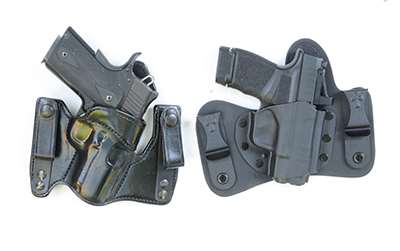
Several people I know wear cross-draw holsters for concealed carry for various reasons. One is confined to a wheelchair, another has arthritis in both shoulders and a third has rotator-cuff issues. The seating in one of our favorite restaurants is all booths, and, when dining there, I feel more comfortable with my Glock 19 in a Galco Hornet. When asked why she carries cross-draw, the driver of a local delivery truck stated that during a violent riot, she was forced to vacate the vehicle so quickly that she was unable to retrieve her handgun from the console. Prior to carrying concealed while driving an automobile, check local and state laws to make sure it is legal.
Here is a really good thing about the cross-draw holster: Should your strong-side hand become injured during an attack, the reverse cavalry draw will quickly have the gun in your weak-side hand with its muzzle pointed in the right direction. But there are negatives as well—drawing and presenting a gun is slower from a cross-draw holster than from a holster on the dominant side, but with sufficient practice, not by much. During a sudden, surprise frontal attack, an assailant who reaches you before the gun is drawn could pin your arm against your body, and due to the butt-forward position of the gun, draw it and bang away. For this reason, a holster with auto-locking mechanical retention with intuitive release by the person carrying it is certainly worthy of consideration.
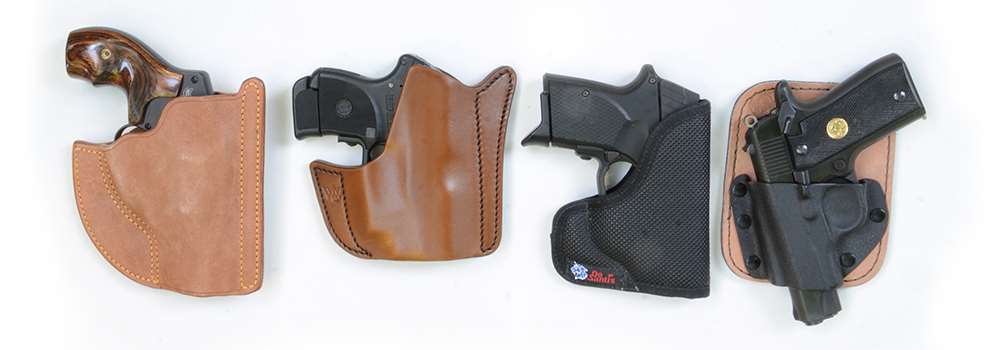
Pocket Carry
Ease of carry and the suitability of a gun for concealment sometimes override optimal cartridge effectiveness, and there are people who, for various reasons and circumstances, must choose between carrying a pocket-size pistol or not carrying at all. Said another way, a .380 ACP in the pocket when something really bad goes down is preferable to a .45 ACP left at home. The .380 has long been king of pocket-pistol cartridges, and while some guns in 9 mm Luger have become considerably smaller and lighter than in the past, they are still noticeably larger and heavier than .380s such as the Ruger LCP, KelTec P3AT and Kahr P380. For those who prefer a wheelgun, various Smith & Wesson J-frames without an exposed hammer spur in .38 Spl. are popular choices.
A pocket holster keeps the gun oriented for a smooth, fumble-free draw. It also prevents the outline of a gun from printing through clothing, and it protects the gun from pocket lint and dusty conditions. For safety’s sake, the loaded gun should be holstered prior to being placed into the pocket. Either by shape or by the surface texture of the material it is made of (sometimes both), a properly designed holster will remain in the pocket as the gun is drawn. This is more likely to be the case for those made of leather, such as the Galco Front Pocket and the Wright Leather Works Bandicoot. Do not try to re-holster a gun with the holster in the pocket; shift the gun to the weak-side hand and remove the holster from the pocket. Then, without allowing the muzzle to sweep any part of the body (including a hand), re-holster the gun and place it back into the pocket.
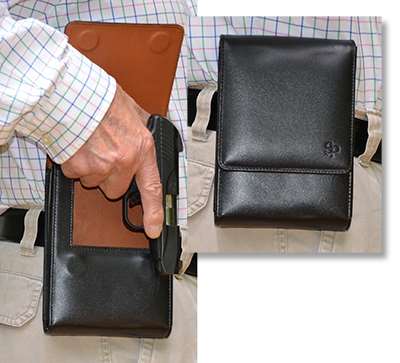
Drawing the gun from a pants pocket while sitting in a restaurant or other place can be difficult, but, with practice, it can be done, unless pant fit is extremely tight. If a coat or jacket is worn, transferring the holstered gun to a more accessible pocket prior to entering the establishment is an option. A big advantage in favor of carrying in a front pant pocket or a jacket pocket is that, during a high-alert situation, the hand can be discreetly gripping the gun while standing or nonchalantly walking along. Doing so transforms fairly slow gun access to quicker than for most other carry positions. Nothing else should be in a pocket containing the holstered gun, and that includes a smartphone, car keys and loose change.
Final Thoughts
Regardless of the type of holster chosen, it must be comfortable when standing, walking, sitting or all the other activities its wearer might subject it to. And it must remain so when worn for hours each day. If it is not, the temptation to leave the firearm behind will be great. If, at first, a holster of known quality and design does not feel right, give it time to conform to your body. Chances are you will eventually pay very little attention to its presence on your belt. Two weeks of daily wear should begin to tell the story, and some companies make doing so risk-free. CrossBreed, for example, has a 30-day trial warranty that promises to buy back a holster if it is returned within that time frame.
When choosing a new holster, I suggest placing the highest priority on quality, how it is designed to be worn, its ability to conceal, its comfort after a reasonable break-in time and its retention qualities—for a practical solution that should keep you well-prepared.
Holster Grip
A good holster grips a gun firmly enough to prevent it from falling out when its user runs, jumps or falls down and yet not so tightly so as to prevent a smooth draw. Even so, a hand should hold the gun in place while running or engaging in other physical activity. Many holsters designed for concealed carry are of passive-tension design, which means its shape, stiffness and close fit keep a gun in place. Some have an adjustable tension screw, but it alone is seldom enough to secure the gun. To test retention, place the unloaded gun in the holster and, with a hand wrapped around the holster, turn it upside down over a large cushion and give it a shake. When new, some leather holsters will grip a gun too tightly. If so, place the gun in a thin plastic bag, insert it into the holster and leave it there overnight. Another option is applying Galco Draw-Ez to the inside of the holster.
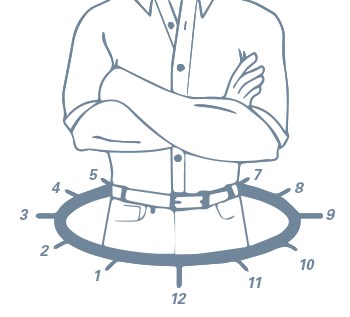 Holster Practice
Holster Practice
The various body-clock positions present a wide range of carry options. Once you’ve selected a holster and carry style, using an unloaded gun, practice drawing and dry-firing, including with the non-dominant hand—a skill that could be necessary in case the strong hand becomes injured. If the gun is carried behind the hip, reach across your back, grasp its grip and draw. If it is at 3 o’clock, reach across the front of your body, draw the gun by grasping the grip with thumb and fingers, bring it upright with the grip in the palm of the hand and then assume a normal grip. As the gun is brought around to the weak side, be sure to keep its muzzle pointed down and away from your body. Weak-hand draw is easiest with a cross-draw holster—simply do a reverse cavalry draw. During practice sessions, start slowly, and reasonable speed will come with time.












